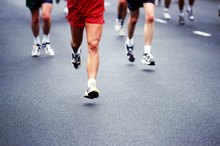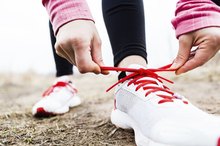Can Certain Exercises Realign the Patella?
Patellar alignment issues are common sources of knee pain. The patella, or kneecap, moves up and down as the knee bends and straightens. It moves on a "track" called the trochlear groove. When the kneecap doesn't move on the groove correctly, the condition is referred to as a patellar alignment (or tracking) problem. Occasionally, abnormalities in ankle and knee posture can lead to patellar alignment issues. More commonly, though, muscular imbalance or weakness will lead to alignment issues, and this is something that in most cases can be corrected with specific exercises.
Quad Sets
The simplest of exercises for the quadriceps (front of the thigh) muscles, quad sets are performed with the leg resting in a straight position. To do the exercise, tighten up the muscles in the front of your thigh as if trying to straighten your leg even straighter. Hold this contraction for three to five seconds and then relax. Try doing 15 of these to start with.
- The simplest of exercises for the quadriceps (front of the thigh) muscles, quad sets are performed with the leg resting in a straight position.
- To do the exercise, tighten up the muscles in the front of your thigh as if trying to straighten your leg even straighter.
Short Arc Quad Sets
How to Strengthen the Patella Tendon
Learn More
Short arc quad sets are performed with the leg resting out in front of you, but you'll need something small resting under the bend of your knee. A rolled up towel or small pillow will work well for this. After you place the roll there, your knee should be slightly bent. In this position, tighten up the muscles in the front of your thigh while at the same time pushing the back of your knee into the roll. Your ankle and foot should lift up from the surface, but the back of the knee should still be touching the roll. Try to do 15 repetitions, holding each for three to five seconds.
- Short arc quad sets are performed with the leg resting out in front of you, but you'll need something small resting under the bend of your knee.
- Your ankle and foot should lift up from the surface, but the back of the knee should still be touching the roll.
Straight Leg Raises
A more difficult exercise is the straight leg raise. Lie flat on your back. For comfort, you can have one knee slightly bent. You'll first want to tighten up the muscles on the front of the thigh of the leg that is straight -- this is the leg that will be doing the exercise. Once they are tight, slowly raise the leg off the surface anywhere from 1 to 2 feet. Be sure to keep the knee straight the entire time by holding the quadriceps muscles tight. After holding in the lifted position two to three seconds, slowly lower the leg back down to the starting position. Start out with 10 to 15 of these. As they get easier, you may try and do them in a semi-reclined position.
- A more difficult exercise is the straight leg raise.
- After holding in the lifted position two to three seconds, slowly lower the leg back down to the starting position.
Adductor Squeezes
Exercises For Sesamoiditis
Learn More
A simple but effective exercise for the inner thigh or adductor muscles is the adductor squeeze. This is commonly done with a ball or folded pillow, but anything similar will work. In the sitting position, place the ball or pillow between your knees. Squeeze both knees together, squishing the ball or pillow. Hold the squeeze for three to five seconds and then relax. Start with 10 to 15 repetitions.
- A simple but effective exercise for the inner thigh or adductor muscles is the adductor squeeze.
- Squeeze both knees together, squishing the ball or pillow.
Related Articles
References
- Cigna: Patellar Tracking Disorder: Exercises
- Peters JS, Tyson NL. Proximal exercises are effective in treating patellofemoral pain syndrome: a systematic review. Int J Sports Phys Ther. 2013;8(5):689-700.
- Kaya D, Doral MN, Callaghan M. How can we strengthen the quadriceps femoris in patients with patellofemoral pain syndrome?. Muscles Ligaments Tendons J. 2012;2(1):25-32.
- Chan MK, Chow KW, Lai AY, Mak NK, Sze JC, Tsang SM. The effects of therapeutic hip exercise with abdominal core activation on recruitment of the hip muscles. BMC Musculoskelet Disord. 2017;18(1):313. doi:10.1186/s12891-017-1674-2
- Burnet EN, Pidcoe PE. Isometric gluteus medius muscle torque and frontal plane pelvic motion during running. J Sports Sci Med. 2009;8(2):284–288.
- Gong W. The effects of the continuous bridge exercise on the thickness of abdominal muscles in normal adults. J Phys Ther Sci. 2018;30(7):921-925. doi:10.1589/jpts.30.921
- Keller JL, Fritz N, Chiang CC, et al. Adapted Resistance Training Improves Strength in Eight Weeks in Individuals with Multiple Sclerosis. J Vis Exp. 2016;(107):e53449. doi:10.3791/53449
- Davies G, Riemann BL, Manske R. Current concepts of plyometric exercise. Int J Sports Phys Ther. 2015;10(6):760-86.
- Janssens L, Brumagne S, Mcconnell AK, et al. Proprioceptive changes impair balance control in individuals with chronic obstructive pulmonary disease. PLoS ONE. 2013;8(3):e57949. doi:10.1371/journal.pone.0057949
Writer Bio
Amanda Willis is a practicing physical therapist in Little Rock, Ark., who specializes in adult orthopedic conditions. She received a Bachelor of Science in health science and her doctoral degree in physical therapy at the University of Central Arkansas. She currently practices at the University of Arkansas for Medical Sciences.









